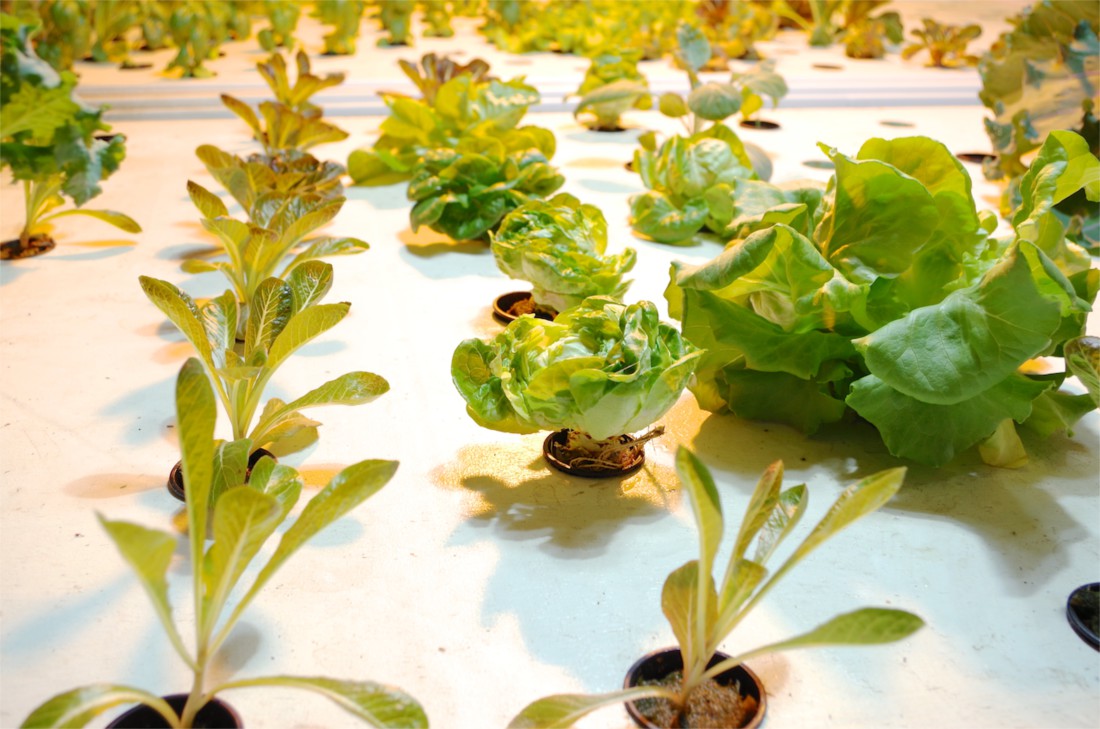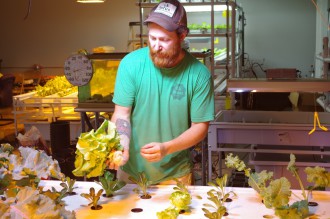Brook Sheffield and his colleagues keep a rack of longboard skateboards by the door of their retail shop, at the ready to hop on and roll over to their production facility. They could easily walk between the locations, which are just across a small parking lot from one another, but the boards are faster and more fun. Why not do things differently?
L.O.T.U.S. Urban Farm and Garden Supply opened in Asheville in January 2014. Founder and co-owner Sheffield grew up in Tarboro watching his father work in their home garden, but he later joined the corporate world, working as a wine and beer sales representative for a subsidiary of Berkshire Hathaway. He soon realized he preferred T-shirts to business suits, rooster to alarm clock. Now, in addition to L.O.T.U.S., Sheffield has a 5-acre homestead in Leicester, where he raises chickens, goats, pigs, turkeys, guineas and bees, and tends a small orchard.
A box of live chicks sits in the middle of the L.O.T.U.S. retail store, and a large vat of compost tea brews by the door. There’s lots going on here — everything from sales of greenhouse equipment and organic livestock feed to beehive removal. But, says Sheffield, the jewel of his experience is the aquaponics system.
Sheffield opens the door to the production facility, also known as the “L.O.T.U.S. Learning Lab,” and invites me inside. In addition to being a place for growing plants, the space doubles as an education center, with doors open seven days a week to serve anyone who wants to come in and learn. “We set this place up to showcase the ideas that we believe will lead the future food revolution,” says Sheffield, who believes aquaponics is the answer to world problems like food safety and security.
Aquaponics is the marriage of aquaculture (the cultivation of aquatic animals and plants) and hydroponics (soilless plant cultivation). It’s essentially a natural pond cycle. But instead of having all the elements — fish, bacteria, plants — in one big soup, in aquaponics, they’re kept discrete, except for the common element of water running through. “We’re mimicking nature’s systems, because they’re the most efficient,” says Sheffield.
Aquaponics enables plants to be grown using about 90 percent less water than other farming methods, because the water in the system (in L.O.T.U.S.’s case, about 2,000 gallons) is never taken out — it just continues to cycle through and be cleaned and reused.
The L.O.T.U.S. team uses aquaponics to grow mostly leafy greens and herbs like lettuce, kale, basil and microgreens. “We only sell stuff living,” Sheffield explains — in other words, roots intact. He pulls a kalette (a kale and Brussels sprout hybrid plant) out of the water, and its roots extend down at least 3 feet like a magic ladder. In soil gardening, this wouldn’t be possible — the roots would break when you pulled them out of the ground. And the minute you remove the root zone from a plant, Sheffield explains, it no longer has a connection to its nutrient source, and it begins to die. “Why remove the root source when you can keep it on?” says Sheffield. “It’s a no-brainer for us.”
The company’s biggest-selling crop is lettuce. “L.O.T.U.S. living lettuce,” as Sheffiled refers to it. L.O.T.U.S. sells mainly the Bibb variety, with Rex Butterhead the top seller in winter, and summer crisp the best seller in summer. L.O.T.U.S. also grows Salanova and romaine. With aquaponics, says Sheffield, “we have the pleasure of being able to produce some of the finest lettuce in the middle of winter.” And because it still has its roots, L.O.T.U.S. living lettuce will stay fresh, and even grow, for up to three weeks in the fridge. Customers have the choice of eating the lettuce like normal, store-bought lettuce or replanting it in a cup of water or their garden to harvest at their leisure.
To set up the L.O.T.U.S. aquaponics system, Sheffield worked with Jonathan Glauser of Mountain Well-Being and followed the University of Virgin Islands model. Water flows from fish tanks, where the L.O.T.U.S. team raises tilapia, to two filtration barrels. Here, dirty water from the fish waste is cleaned through filtration and bacterial processes that turn ammonia to nitrite, and nitrite into plant-fertilizing nitrate. The water then runs to a degassing tank, where the sulphur or methane built up from decomposition can be gassed off. Next, it flows down troughs in the plant beds and then, thanks to a small pump, returns to the fish tanks. The fish are positioned highest in the system, permitting gravity to do all of the other flow work.
“I believe this water to be… 100 percent safe to drink,” Sheffield says, lifting up the plant bed cover and scooping a handful of water into his mouth.
But to someone unused to aquaponics, the system seems, well, artificial — perhaps something out of a science fiction novel. The principles involved, though, aren’t new. Ancient Egyptians used rafts, floating over lakes and rivers, to grow plants in water, while the Aztecs created man-made floating islands called chinampas.
“I’ll be the first to admit that this is not the most natural-looking thing,” Sheffield says. “But looks can be very deceiving.”
He thinks aquaponics systems are more natural than your conventionally grown (read: chemically sprayed) supermarket produce. “If you hang around the food and the fish long enough,” he notes, “this might feel more natural than a lot of other things that you’re doing in your daily life, like driving your car and riding around in airplanes, and hopping on the World Wide Web.”
Sheffield’s enthusiasm about aquaponics is contagious, and he believes others are just as excited about it. “We’re not just doing this in our backyards anymore,” he says. “We’re going big.”
“Our hope,” says Sheffield, “is that we can convert commercial farming techniques that are destroying our land into more sustainable techniques like this that will conserve water, use less pesticides, herbicides and chemicals, and essentially restore life back to our land.” Not to replace organic soil farming, he says, but to complement it, for purposes of food security and climate change, as well as health and water conservation.
Sheffield thinks that in 20 years, aquaponics will be everywhere. It’s already huge in Australia, where heat and drought are serious problems. And it’s becoming widespread closer to home, too, with systems popping up all over Asheville.
“In North Carolina, we’ve already got a great growing season,” says Sheffield. “But if you just take a better growing technique and put it in a great growing season, and that growing technique also cuts down on labor, cost and a number of other inputs, then all you’ve done is made your job easier, made more money and made the right decision for the environment at the exact same time. I think North Carolinians and people all over the country are just waking up to the obviousness of this idea.”
One of L.O.T.U.S.’s main goals is to spread the word about how important, and potentially world-saving, the aquaponics growing method really is. “We need to be teaching people how to live a life that’s worth living, not just to be consumers,” Sheffield says. And sometimes, the best solution to a problem means stepping away from traditional models and taking things into your own hands.
Sheffield reaches for his longboard and glides across the parking lot, in a single motion bringing the flow and efficiency of the LO.T.U.S. Learning Lab aquaponics system back to the retail store.
Visit the L.O.T.U.S. Learning Lab at 455-8 N. Louisiana Ave. in Asheville. Find living lettuce and other L.O.T.U.S. greens and herbs at the French Broad Food Co-op Wednesday Tailgate Market and West Village Market, as well as restaurants like The Blackbird, HomeGrown and Chestnut.
This story was originally published on Carla Seidl’s website, Earth Flavors.




Before you comment
The comments section is here to provide a platform for civil dialogue on the issues we face together as a local community. Xpress is committed to offering this platform for all voices, but when the tone of the discussion gets nasty or strays off topic, we believe many people choose not to participate. Xpress editors are determined to moderate comments to ensure a constructive interchange is maintained. All comments judged not to be in keeping with the spirit of civil discourse will be removed and repeat violators will be banned. See here for our terms of service. Thank you for being part of this effort to promote respectful discussion.